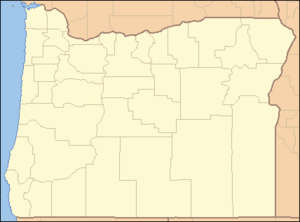Little Butte Creek
| Little Butte Creek | |
|
The north fork of Little Butte Creek
|
|
| Name origin: Named after Snowy Butte (now Mount McLoughlin) | |
| Country | United States |
|---|---|
| State | Oregon |
| Counties | Jackson County, Klamath County |
| Source | Near Lake Creek |
| - location | Cascade Range, Jackson County, Oregon |
| - elevation | 1,647 ft (502.0 m) |
| - coordinates | 42°25′11″N 122°37′08″W / 42.41972°N 122.61889°W |
| Mouth | Rogue River |
| - location | about 3 miles (4.8 km) southwest of Eagle Point, Jackson County, Oregon |
| - elevation | 1,204 ft (367.0 m) |
| - coordinates | 42°27′03″N 122°52′47″W / 42.45083°N 122.87972°WCoordinates: 42°27′03″N 122°52′47″W / 42.45083°N 122.87972°W |
| Length | 17 mi (27 km) |
| Basin | 373 sq mi (966 km2) |
| Discharge | for below Eagle Point |
| - average | 232.3 cu ft/s (6.578 m3/s) |
| - max | 10,000 cu ft/s (283 m3/s) (January 7, 1948) |
| - min | 5.8 cu ft/s (0.16 m3/s) (June 6, 1926) |
|
The Little Butte Creek watershed
|
|
Little Butte Creek is a 17-mile-long (27 km) tributary of the Rogue River in the U.S. state of Oregon. Its drainage basin consists of approximately 354 square miles (917 km2) of Jackson County and another 19 square miles (49 km2) of Klamath County. Its two forks, the North Fork and the South Fork, both begin high in the Cascade Range near Mount McLoughlin and Brown Mountain. They both flow generally west until they meet near Lake Creek. The main stem continues west, flowing through the communities of Brownsboro, Eagle Point, and White City, before finally emptying into the Rogue River about 3 miles (5 km) southwest of Eagle Point.
Little Butte Creek's watershed was originally settled by the Takelma, and possibly the Shasta tribes of Native Americans. In the Rogue River Wars of the 1850s, most of the Native Americans were either killed or forced onto Indian reservations. Early settlers named Little Butte Creek and nearby Big Butte Creek after their proximity to Mount McLoughlin, which was known as Snowy Butte. In the late 19th century, the watershed was primarily used for agriculture and lumber production. The city of Eagle Point was incorporated in 1911, and remains the only incorporated town within the watershed's boundaries.
...
Wikipedia



